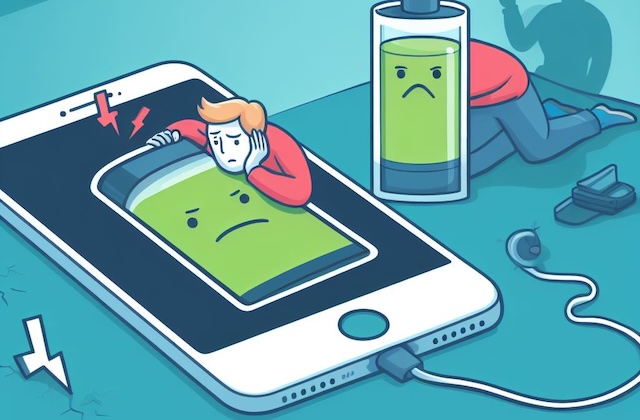
Disclaimer:
This post is a fictitious case study example created for educational and illustrative purposes only. Any references to any company, its products, or services are purely fictional and do not imply endorsement, affiliation, or association with the actual company.
This case study delves into a pressing issue faced by myPhone users – battery life. We’ll explore how Mapple, a tech giant with a stellar reputation, addressed this problem and improved the myPhone user experience. From identifying the problem to implementing solutions, Let us take the journey through each crucial step.
😵💫 The Foundation: Problem Statement
Problem Statement: Users of Mapple’s myPhone are facing significant challenges related to battery life. The issue impacts user satisfaction and device performance. User surveys reveal that 70% of myPhone users are dissatisfied with their device’s battery life, resulting in frustration and limitations in daily usage.
🍎 Company Information
➡️ Company Overview: Mapple Inc., a global technology company, is known for its innovation and premium products. With a mission to design products that enrich people’s lives, Mapple has built a devoted user base, generating billions in revenue. The company’s product portfolio includes myPhones, myTabs, and myWatch.
⚔️ Competitors: Key competitors include Ramsung, Roogle, and Ruawei. Mapple’s strengths lie in its brand loyalty, ecosystem integration, and design aesthetics.
*️⃣ Market Size and Opportunity
🏪 Market Research: The global smartphone market is estimated at $1.3 trillion. Battery life is a major concern for almost all smartphone users, with surveys indicating that longer battery life is a top priority. 90% of users are willing to switch brands for better battery performance.
🤑 Opportunity: The opportunity here is significant. Improving myPhone battery life will not only enhance user satisfaction but also attract users from competitors. Targeting a larger market share by addressing this problem is a strategic move.
User Persona
- Name: Sarah
- Characteristics: 32-year-old professional, heavy smartphone user, relies on her myPhone for work, active on social media, values seamless connectivity.
- Needs: Long-lasting battery life, reliable communication, uninterrupted work, and a device that keeps up with her busy lifestyle.
- Goals: Maximize productivity, stay connected, and avoid the frustration of frequent charging.
- Pain Points: Short battery life disrupts her work, forces frequent charging, and impacts her ability to stay connected and productive.
😁 User Journey – Happy Scenario
- Sarah starts her day with a fully charged myPhone.
- She uses her phone throughout the day for work, social media, and calls.
- Her myPhone battery lasts the entire day with power to spare.
- Sarah praises her myPhone’s performance and reliability.
🙁 User Journey – Unhappy Scenario
- Sarah starts her day with a fully charged myPhone.
- She uses her phone for work, social media, and calls.
- By midday, her battery is critically low, causing anxiety.
- Sarah must find a charger or portable power source, disrupting her day.
- She is frustrated with her myPhone’s battery performance.
👨🔬 Possible Solutions
- Battery Optimization: Fine-tune the operating system to optimize battery usage.
- Enhanced Battery Technology: Develop advanced battery technology to extend battery life.
- Low-Power Mode Improvements: Improve the low-power mode to further extend usage.
- Battery Health Notifications: Implement proactive notifications to users regarding battery health and performance.
- App Energy Consumption Management: Work with app developers to reduce energy consumption.
🤷♂️ User Prioritization Frameworks

🏆 Success Metrics
- Increase in User Satisfaction: Aim for a 30% increase in user satisfaction regarding battery life.
- Reduced Charging Frequency: A 25% reduction in the frequency of users needing to charge their myPhones.
- Market Share Growth: Target a 5% increase in market share due to improved battery life.
🛍️ Go-To-Market Strategy
1️⃣ Marketing Campaign: Launch a comprehensive marketing campaign highlighting the improved battery life of myPhones, emphasizing their reliability and user satisfaction. Make use of digital marketing tools, social media, and partnerships with tech influencers.
2️⃣ Collaboration with App Developers: Collaborate with app developers to optimize their apps for energy efficiency. Encourage them to update their apps for better battery performance.
3️⃣ Product Integration: Ensure that the improvements in battery life are seamlessly integrated into OS updates.
4️⃣ User Training: Develop user training materials to educate myPhone users on battery-saving techniques and best practices.
5️⃣ Customer Support: Enhance customer support to assist users with any battery-related queries or issues.
🔔 Conclusion: Enhancing User Experience
By addressing the issue of myPhone battery life, Mapple not only improves user satisfaction but also captures a significant market opportunity. This case study exemplifies how a tech giant leveraged its strengths, addressed a critical problem, and implemented a user-centric solution.
As product managers, we can draw inspiration from this case study to resolve user pain points and enhance the overall product experience. In a competitive market, prioritizing user satisfaction through innovative solutions is the path to maintaining brand loyalty and capturing new audiences.
If you arrived at this post via some link and want to learn more about product management, you can also find other posts. The Full series is available here
💌 Do drop me a comment below if you found the content useful and/or want me to write on a specific topic. This will make my day! 🙂
Also, share the post if you think this might help someone. The sharing link is at the top of the page.
Join FreeMentor as a student if you are a newbie in product management and want to have one Free 1:1 mentorship session.
#ProductManagement #CaseStudy #UserCentric #BatteryLife #Innovation 📱🔋

